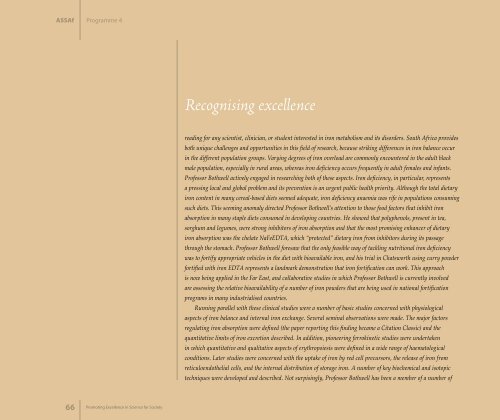Academy of Science South Africa 2005/6 Annual Report
Academy of Science South Africa 2005/6 Annual Report
Academy of Science South Africa 2005/6 Annual Report
- No tags were found...
You also want an ePaper? Increase the reach of your titles
YUMPU automatically turns print PDFs into web optimized ePapers that Google loves.
ASSAfProgramme 4Recognising excellencereading for any scientist, clinician, or student interested in iron metabolism and its disorders. <strong>South</strong> <strong>Africa</strong> providesboth unique challenges and opportunities in this field <strong>of</strong> research, because striking differences in iron balance occurin the different population groups. Varying degrees <strong>of</strong> iron overload are commonly encountered in the adult blackmale population, especially in rural areas, whereas iron deficiency occurs frequently in adult females and infants.Pr<strong>of</strong>essor Bothwell actively engaged in researching both <strong>of</strong> these aspects. Iron deficiency, in particular, representsa pressing local and global problem and its prevention is an urgent public health priority. Although the total dietaryiron content in many cereal-based diets seemed adequate, iron deficiency anaemia was rife in populations consumingsuch diets. This seeming anomaly directed Pr<strong>of</strong>essor Bothwell’s attention to those food factors that inhibit ironabsorption in many staple diets consumed in developing countries. He showed that polyphenols, present in tea,sorghum and legumes, were strong inhibitors <strong>of</strong> iron absorption and that the most promising enhancer <strong>of</strong> dietaryiron absorption was the chelate NaFeEDTA, which “protected” dietary iron from inhibitors during its passagethrough the stomach. Pr<strong>of</strong>essor Bothwell foresaw that the only feasible way <strong>of</strong> tackling nutritional iron deficiencywas to fortify appropriate vehicles in the diet with bioavailable iron, and his trial in Chatsworth using curry powderfortified with iron EDTA represents a landmark demonstration that iron fortification can work. This approachis now being applied in the Far East, and collaborative studies in which Pr<strong>of</strong>essor Bothwell is currently involvedare assessing the relative bioavailability <strong>of</strong> a number <strong>of</strong> iron powders that are being used in national fortificationprograms in many industrialised countries.Running parallel with these clinical studies were a number <strong>of</strong> basic studies concerned with physiologicalaspects <strong>of</strong> iron balance and internal iron exchange. Several seminal observations were made. The major factorsregulating iron absorption were defined (the paper reporting this finding became a Citation Classic) and thequantitative limits <strong>of</strong> iron excretion described. In addition, pioneering ferrokinetic studies were undertakenin which quantitative and qualitative aspects <strong>of</strong> erythropoiesis were defined in a wide range <strong>of</strong> haematologicalconditions. Later studies were concerned with the uptake <strong>of</strong> iron by red cell precursors, the release <strong>of</strong> iron fromreticuloendothelial cells, and the internal distribution <strong>of</strong> storage iron. A number <strong>of</strong> key biochemical and isotopictechniques were developed and described. Not surpisingly, Pr<strong>of</strong>essor Bothwell has been a member <strong>of</strong> a number <strong>of</strong>66 Promoting Excellence in <strong>Science</strong> for Society









![National Research Foundation Annual Report 2008 / 2009 [Part 2]](https://img.yumpu.com/49774036/1/177x260/national-research-foundation-annual-report-2008-2009-part-2.jpg?quality=85)






